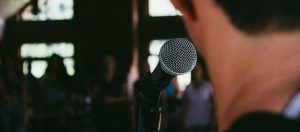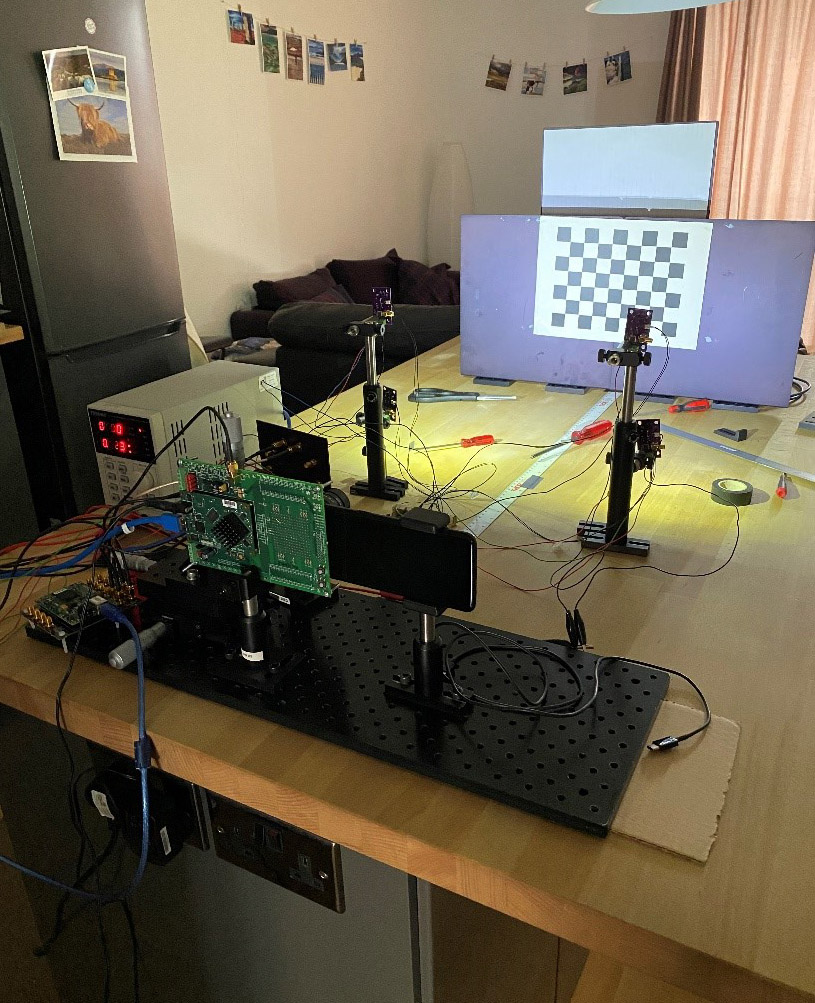
Recently, we at SCOPE have decided to bring you a series of short-form articles written by our chapter members, broadly focused on useful skills, knowledge and personal development. Since each of our chapter members has a unique skillset and comes from a different background, we wanted to do something that will let us learn from each other and introduce interesting new thoughts and ideas.
This article was contributed by Emma Le Francois, the President of SCOPE, on 29/3/2020.
Many thanks to Christine Haas (Christine Haas Consulting, LLC, www.christinehaasconsulting.com) and Anne Ricketts (Lighthouse Communications, LLC, www.lighthousecommunicate.com) for their kind agreement to share excerpts from their work on the Business of Storytelling workshop. Photograph by Marcos Luiz.
Last year, I had the chance to attend two different international conferences with SPIE and OSA to represent SCOPE. I travelled to both San Francisco and Washington DC on my own and it was the best experience I ever had. I got to learn that it is actually possible (and enjoyableú to travel juston your own! On the way, I had to deal with some minor issues, like that time I almost got stuck in the San Francisco airport train station because I didn’t put enough money on the travel pass. I also witnessed few crazy things, such as a guy in the tramway in San Francisco preciously holding a big tree trunk. Nevertheless, I mostly met amazing people: other students from different chapters, but also this lovely old lady with whom I stayed in an AirBnB. All those are perks of being a SCOPE member – it brings you a lot of opportunities, both personal and professional. Despite these complicated times, we want to stay active for you and share with you all the advices I obtained during these Student Leadership Workshops.
For this week #SCOPEreads article, I want to share with you the content of an interesting and useful workshop I attended on “The Business of Storytelling”. This workshop was given by Christine Haas at the Student Leadership Workshop hosted by SPIE during the Photonics West Conference in San Francisco. I found this talk helpful as I realised that every presentation that I give always starts in the usual, boring way: “Hello, my name is Emma Le Francois and today I’m going to talk about …”. This is the best way to lose the attention of the audience. You may be in the same situation as me when you attend an all-day conference: if the speaker starts his talk in a low voice, without saying something intriguing or involving the audience by asking a question, my attention quickly shifts to something like “Oh when is the next tea break session?”. During my master degree, I had some classes about how to do a good presentation, how to structure it etc., but only after this workshop, I realised “No one ever advised me to start a talk with an anecdote or a question”. All the content of these classes was focused on scholar and technical talks. Moreover, whenever I watch TED talks, I always tell myself “I wish I could speak with such confidence and start my talk with a good story”.
Today, let’s see how we can hook our audience, keep their attention and show people that the talk is relevant to them. This article is based on the workbook from Christine Haas and Anne Ricketts.
a) How to start a short story?
I guess this is the hardest bit: how can we come up with a short story when we work in physics? I know some of you work in hard theoretical physics – so how can we come up with a story? I haven’t had the chance to give a proper presentation about my current work yet. Nonetheless, when I gave this 3min talk to introduce my poster, there was no time for a story and I wished I would have had the time to talk about a funny anecdote, because it would have decreased my level of stress. At the moment, I’m working on a new experimental setup and because of the lockdown, I brought the setup home (see picture below) as I want to present this work soon at an IEEE international conference.

I will use this situation as an anecdote at the beginning of my talk to show that in Physics, we always come up with ideas or ways to be innovative and pragmatic. You must have something that went wrong at some point in your experiment or your simulation. Maybe you can use that and describe how you felt during this time, what was wrong and how you managed to deal with the issue. As you develop your story, you need to think about these three elements:
- Was there a change in values, beliefs, or results from the beginning to the end of the story?
- What were the emotions involved during the story? (frustration, sadness, relief, excitement, happiness)
- What details can you include to make the story more vivid? (character description, setting description, product description, analogies)
b) When to use a story?
A story can be useful if you want to connect with the public. You are not talking just to yourself; you want to deliver a message to them, and you want to make sure that they understand this message. When you think about your story, it makes you think about your audience. How much do they know about your topic? A story can also help you provide an example of a bigger concept especially if you need to explain hard theoretical physics that can be hard to follow for the audience. Your story does not have to be an anecdote, it can be a simple example or a question. For example, I remember a talk about plasma and lasers and the speaker made a funny, easy-to-visualize comparison to a tide wave where the electrons would surf on the wave. You can also use a story to teach a lesson or motivate and inspire the audience.
c) Five elements for a great story
First, you want your audience to be interested and engaged in your story and for this you need a shift. For example, I am working on the calibration of two different cameras. After looking for information on Mathworks about a calibrator application, one of the comments was “Why are you looking for something complicated in calibrated different cameras when all you have to do is to buy two identical cameras?” From there, I was thinking whether “am I doing something feasible?” and yes! I did succeed in calibrating these two diametrically different cameras. There is a shift in result from non-feasible to feasible. In every good story, there is a shift in values, beliefs or results.
Secondly, if you want the audience to identify with you, you need to infuse your story with some emotions and feelings. How did you feel when the simulation you have been working on for six months was a success? Personally, I felt proud when I came up with results that would make a paper. And you? How did you feel? Remember that people tend to forget facts, but they tend to remember emotions and feelings quite well.
Another element is the descriptive details in your story. How can the audience be with you as you tell your story without any important details? For a good story, you need to paint a picture. If you talk about analysing a huge amount of data instead of using “huge amount of data” you can use a number “For this simulation, I had to deal with 100 Gb of data and find a computational way to go through it without crushing the computer”. It is better to show than to tell. But be careful as you don’t want to give too much details as the audience might get lost. Just give details that matter and a descriptive language that uses the five senses.
Moreover, a good story is a story that starts and end strong. Don’t lose time saying “I’m going to tell you a story about…” because first you only have a determined amount of time for your talk and second you don’t want to lose the people before you even starting your story. Instead, you can start with “Last week, I was…”, “When I first started to work on …, I felt…”. Use the end of the story to tell the bigger point “All to say that without this problem to solve I would never had discovered this…”, “I tell you this story because …”. It is good practise to rehearse the beginning and ending lines more than any part of the story, so you know where to start and when you are finishing.
Last but not the least, make sure that you stay on track. One of my biggest problem when I tell a story is that I forget, most of the time, why I’m telling someone the story at the first place because I got lost in the details. Make sure your transitions help focus you – make them touch points. Leave out extraneous details that will complicate the story and are unnecessary information. When you prepare the story, you can follow this structure: Point → Reason → Example → Point summarised.
d) Conclusion
At some point in our studies, we must give a public talk and we can all agree that this is a challenging task. To sum up a bit, a story can be an effective way to hook an audience as long we are efficient and have a specific message to deliver. All you have to remember for a good story is that it has to bring the public with you by showing emotions, demonstrating the shift, by describing the scene, staying on track and have a strong start and end. We all have stories to share about our work or lives, some anecdotes. Remember that you can always test your story before your talk with some friends and colleagues.
That’s the end of the article. I hope you found it useful ? I’m looking forward to hearing about your comments on the topic, do not hesitate to share your thoughts on our Facebook page! If you want to refer to some talks or books here is a list of resources:
Books
Gallo, Carmine (2014), Talk Like TED. New York: St. Martin’s Press.
Godin, Seth. All Marketers Are Liars: The Power of Telling Authentic Stories in a Low-Trust World. London: Penguin Group 2005.
Goleman, Daniel. Emotional Intelligence: Why It Can matter More than I.Q. New York: Bantam Books, 1995.
Knaflic, Cole Nussbaumer. Storytelling with Data. Wiley, 2015.
Lamott, Anne. Bird by bird: Some instructions on Writing and Life. New York: Anchor Books/Doubleday 1994.
Simmons, Annette. The Story Factor: Inspiration, Influence and Persuasion through the Art of Storytelling, 2nd edition, Boston Books, 2006.
Simmons, Annette. Whoever Tells the Best Story Wins, 2nd edition, Boston Books, 2007.
Denning, Stephen. The leader’s Guide to Storytelling: Mastering the Art and Discipline of Business Narrative, Edition 2.
Talks
Andrew Stanton: The Clues to a Great Story: https://www.youtube.com/watch?v=KxDwieKpawg (Must see! The catch story is excellent!)
Brené Brown: The Power of Vulnerability: https://www.youtube.com/watch?v=iCvmsMzlF7o
Luis Von Ahn: Massive Scale Online Collaboration : https://www.youtube.com/watch?v=p5v7h4wQDPg
Sheryl Sandberg: Why we have too few women leaders: https://www.youtube.com/watch?v=p5v7h4wQDPg
Steve Jobs 2005 : Stanford Commencement Speech: https://www.youtube.com/watch?v=UF8uR6Z6KLc
Tim Urban: Inside the mind of a master procrastinator https://www.youtube.com/watch?v=arj7oStGLkU (I’m adding this one to the list to get a funny picture of what happens in our procrastinator mind as post-graduate students)
